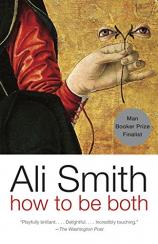How to Be Both
Review
How to Be Both
A lot of writers might call themselves "experimental," but there are few whose work truly is --- and can also cross over into popular consumption and win prestigious mainstream literary awards to boot. One of them is Ali Smith, whose latest novel, HOW TO BE BOTH, was shortlisted for the 2014 Man Booker Prize and, most relevantly, won the Goldsmiths Prize for "boldly original fiction."
HOW TO BE BOTH is printed in two editions. In one (the version I read), the first narrative readers encounter is that of a Renaissance artist, Francesco del Cossa, an Italian fresco painter whose name has been (almost) lost to history. This is followed by a parallel narrative focusing on a modern-day teenage girl, George, coping with the sudden loss of her mother. In the other edition, the printed order of the narratives is switched, so the story of the modern teen is followed by that of the artist. (Did you buy the eBook instead? Lucky you --- you get to choose which edition to read.) Part of what Smith is doing here is to investigate ways of storytelling and of reading and, by extension, of knowing.
"Throughout, Smith's characteristic wordplay, humor and inventiveness make for an incomparably energetic reading experience."
There are moments of convergence in the two narratives (as George's mother tells her, "nothing's not connected"), both of which center, in very different ways, on an actual artistic marvel: the frescoes in the Palazzo Schifanoia (literally, the palace of not being bored) in Ferrara, Italy. Francesco was the artist of three (and, according to Smith, the three best) of the panels composing the 12-panel frieze making up the interior walls of the palazzo. George, for whom a recent trip to Ferrara forms one of her most significant memories with her mother, becomes intrigued not only with Francesco's life and art but also with a related moral conundrum presented to her by her brilliant, politically active mother. That conundrum is also at the heart of Francesco's own story, which focuses on the artist's early training and eventual completion of the frescoes --- as well as Francesco's arrival in a sort of "Purgatorium" that might in fact be our contemporary world ("its people dance by themselves in empty and music-less rooms and they do it by filling their ears with little blocks and swaying about to a silence").
Other than these more literal connections (of which there are many more, large and small), there are also countless thematic parallels in issues of art, love, loyalty, gender, sex, truth and justice. Throughout, Smith's characteristic wordplay, humor and inventiveness make for an incomparably energetic reading experience.
After you've completed HOW TO BE BOTH, it's an interesting exercise to go back and imagine how you would have experienced it differently had you read the two halves in the opposite order. What would you have noticed differently? Where would you be surprised? Also an impossible exercise, certainly, but one that readers will likely find themselves musing over long after finishing this remarkable work of fiction.
Reviewed by Norah Piehl on December 19, 2014
How to Be Both
- Publication Date: October 13, 2015
- Genres: Fiction
- Paperback: 336 pages
- Publisher: Anchor
- ISBN-10: 0307275256
- ISBN-13: 9780307275257





